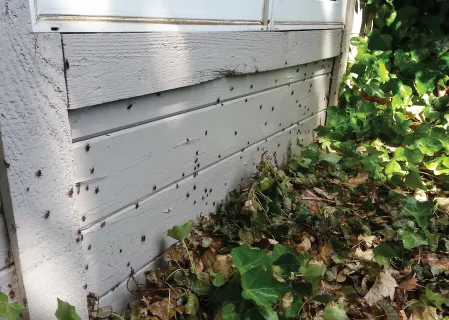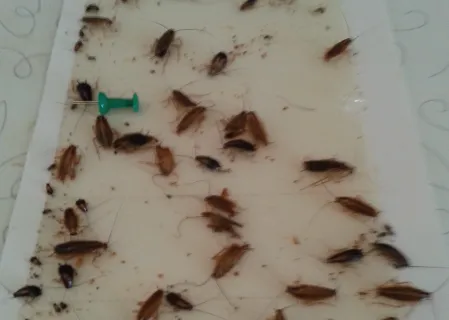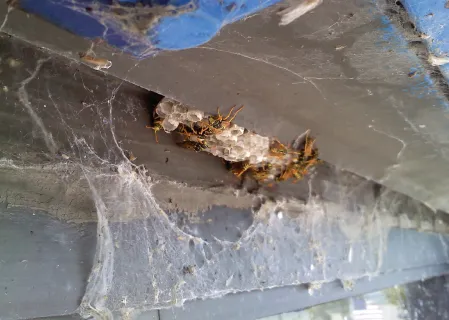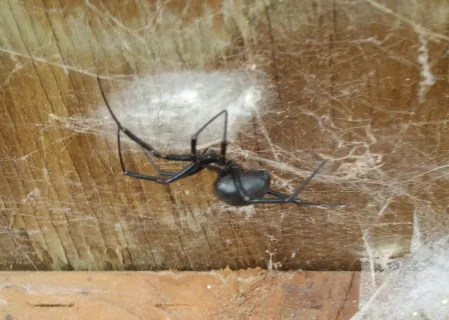Comprehensive Pest Control Services
The longer you wait, the worse it gets! We're here to help!
Pest Control Maintenance Defense System
Your home is surrounded by an uninterrupted barrier of protection from a variety of troublesome pests. We treat your home or business exterior four times per year to keep pests away. Because our exterior barrier is so effective, we only have to treat your home or business interior once a year.
Protect Your Property from Unwanted Pests
Pests systematically seek out entry points and invade residences to obtain food and water. These invaders not only cause physical damage to your home, but can also spread germs, irritate allergies and make your environment, family, and pets uncomfortable. Safeguard your home or business against pests with our comprehensive pest control solutions. Our licensed technicians employ eco-friendly methods to effectively eliminate pests while prioritizing the safety of your family or staff.
The ABV Advantage
Experience Pest Control Excellence with Our Expert Tri-Cities Team
At ABV, we understand that every home and business is unique and that’s why each and every inspection we do will produce a maintenance plan tailored to your specific needs. Whether your home is in Richland or Kennewick, on the river or out in the sand dunes of North Pasco, we’ve got you covered.
- We treat the exterior of your home so you don’t have to be there when treatments are applied, unless your home has pests that have already entered your home.
- ABV’s treatment protects against a variety of Washington pests including box elder bugs, beetles, earwigs, centipedes, pavement ants, spiders, and wasps.
- ABV’s Maintenance Defense System is safe for you, your pets, and the treated area dries quickly.
- Our treatment products are registered for use on grass and ornamental plants.
- ABV’s treatment produces very little odor, so you probably won’t even notice when the barrier is applied.
Kennewick Pest Control & Extermination
Our pest control covers a variety of problematic bugs, rodents, and more. Here at ABV, we will do a detailed inspection of your home or business, and build an integrated pest management program tailored to your specific needs. We offer a variety of treatment options that are safe for people and pets. We have trained technicians who understand where to treat and how to handle infestations. If you are looking to protect a new home or treat an older one, consider the advantages of a pest control program. Some pests we target are ants, bed bugs, beetles, birds, cockroaches, household flies, fleas, indian meal moths, rodents, spiders, wasps/hornets, and more.






There are thousands of species of ants, but only 2 commonly found species in the Tri-Cities. It is necessary to identify the ant species that you have before an effective means of extermination can be used to eradicate them.
Odorous House Ants are about 1/8″ long; make their nests in walls and under floors. Their distinct feature is their smell when their body is crushed –smells like a house cleaner (like 409) or rotten coconut. They do not sting or bite.
Pavement Ants are about 1/8″ long; make their nests in cracks in the pavement and can infest a building. They can sting.
Ant infestation is the most common pest problem reported. These tiny scavengers will enter your home or business looking for moisture and an accessible food source. Sometimes, rotting or damp wood that has mold damage can also attract ants. These tiny insects also feed on sugar, cheese, meats, vegetables, grease, peanut butter, and dead insects.
Out of all the creepy crawly creatures out there, spiders may be the most feared pest that local residents deal with. The way they creep into dark corners and stay hidden behind the walls of a home only add to the anxiety caused by these 8-legged creatures, but there is certainly a rhyme and a reason behind the fear.
Spiders commonly enter homes in two primary ways: entering through open, poorly screened windows and doors and through cracks and gaps around door and window frames. Most of the time, spiders come inside the home looking for prey. The other common method of entry is accidentally hitchhiking inside boxes, on outdoor items and numerous other things that are brought inside a home or business.
Some spiders like moisture and are found in basements, crawl spaces and other damp parts of buildings. Others like dry, warm areas such as subfloor air vents, upper corners of rooms and attics. They hide in dark areas. They feed on insects, other spiders and any other prey they are able to subdue.
Box elder bugs are rapid reproducers and can cause serious damage to your home and garden. These tiny critters move between your yard and house depending on the season. Although they are not dangerous they will consume your plant life and overrun your home. They have an invasive hibernation pattern and will swarm by the thousands.
What do box elder bugs look like? The bodies of box elder bugs are black in color and are marked by red lines along the thorax and sides. Their wings are flat and red. Box elder bugs measure between 11 to 14 mm long.
Box elder bugs do not nest indoors year-round. They usually appear on sunny sides of buildings in the fall. Rather, they make their homes in box elder, maple and ash trees during warmer seasons and migrate into buildings and homes to find shelter for the winter. They enter through small cracks and crevices within the building, and remain inside, hibernating, through fall and winter. They emerge when heat sources within the building are high, and can be located in the warmest areas of a structures walls.
Did you know that these pests also carry deadly diseases? Not only will they introduce fleas, lice, and ticks onto your property, but they’ll also bring the Hantavirus, a disease that causes death in more than 36 percent of people that catch it.
Droppings:
Where there are mice, there are droppings. These small pellets are commonly found anywhere the animals have visited or traveled. Approximately 3 to 6 mm long, the droppings may be rod shaped with pointed ends.
Footprints:
As mice explore their territories, they often leave behind footprints or tracks on surfaces. The distinct pattern of a four-toed front foot and a five-toed back footprint are a clear sign that a mouse has passed by.
Gnawing/Chewing:
House mice are known for their ability to chew on a wide variety of items. In most cases, shavings and a fresh accumulation of debris is often the first indication of damage. Teeth and gnaw marks can also be found along the edges of frequently traveled routes, on the corners of objects or creating openings into an area.
Burrows/Tunnels:
House mice tend to build nests in material that provides a dark and protective environment, such as insulation and other soft materials. These nests are often characterized by openings or tunnels that are free of dust and cobwebs, but may be littered with droppings.
Odor:
House mouse urine plays an important role in communicating with other rodents.
Oftentimes, rodents will mark an area to attract females or warn off other males. A distinct odor may become noticeable in an area with a large rodent population or when rodents have been present for a long period of time.
Wasps pose a serious threat to many homeowners. It’s bad enough to have a large group of wasps circling your house for hours on end, but the situation grows even more dangerous when you throw allergic reactions into the equation. If someone in your house is allergic to wasps, even one sting can result in serious infection or a visit to the emergency room.
PAPER WASPS
The physical appearance of the paper wasp varies by habitat. In fact, in the United States alone, three different species of paper wasps, each with its own striped pattern, can be found in three separate geographical regions. However, all paper wasps share a few traits:
- Slender bodies with a distinct “ waist”
- Black body with yellow bands
- Females have venomous sting, males do not
- In males, curved tips of antennae and more yellow coloring
- Size: 15 to 21 mm
Paper wasp nests are made from plant material combined with saliva and appear to be made from paper. Their nests include numerous compartments within which wasps lay their eggs and rear their young. Similar to other wasp species, northern paper wasps lay fertilized eggs in individual nest cells. Queen bees and subordinate females protect the larvae and cover them with a silk protective lining.
Gophers do not like other gophers and will fight to the death if there is an invader in the tunnels. Only six to eight gophers can inhabit a single acre. It just looks like there are more there.
Pocket gophers are medium-sized rodents from the family Geomyidae. There are varied species of pocket gophers. They range from about 15 to 35 cm in length. Their fur varies in color from black to brown to nearly white and is very soft.
Pocket gophers are able to burrow in lawns and gardens. The tunnels can range from a few inches to a few feet in depth and several hundred feet in length. A unique aspect of the pocket gopher’s burrow is the horseshoe-shaped mound at the surface (moles construct volcano-shaped mounds at the surface of their tunnels). Pocket gophers are most active during the spring and fall when soil is primed for digging.
Their diet includes plant roots, bulbs, tubers such as potatoes and peanuts, and underground plant stems. Gophers eat the roots they find while excavating their tunnels; on vegetation during their infrequent foraging above ground, and they sometimes drag surface vegetation into their tunnel. Pocket gophers get their common name from their cheek “pockets” that are used to carry their food.
Biology does vary slightly, based on the species of pocket gopher. As an example, some have only a single litter of offspring each year, while others can have three to four. The average size of a litter is three to four. Young pocket gophers typically leave the family unit in late summer to early fall and establish their own territories.
Bed bugs are flat, reddish-brown, oval insects up to 4 to 5 mm long or the size of an apple seed. Swollen and reddish after a blood meal.
Bed bugs only feed on blood. Under cool conditions, adult bed bugs have been able to survive up to a year without a meal. They prefer to be more active at night when the host is asleep. Bed bugs are found in cracks and crevices, including mattress seams, sheets, furniture, behind baseboards, electrical outlet plates and picture frames. You can pick up bed bugs almost anywhere — offices, stores, hotels and gyms for starters. They’re great at hiding and have been known to hitchhike in luggage, personal belongings or even you. Once indoors, they can be very difficult to control without the help of an experienced pest specialist. You can reduce your chances of a costly bed bug infestation by catching them early.
If you think you have bed bugs here are some tips:
- Remove all clutter from your home, which makes finding bed bugs easier.
- Wash and dry your bed linens on the hottest temperature permitted.
- Closely inspect any second-hand furniture before bringing it in your home.
- Inspect your home after moving, trips, service calls or overnight guests.
Females can deposit one to five eggs a day, and may lay 200 to 500 eggs in a Bed Bug’s lifetime. Under normal room temperatures and with an adequate food supply, they can live for more than 300 days.
Cockroaches tend to hide well from the human eye, though they do leave small trails that offer proof of a new habitat. If your home is infested by cockroaches, you’ll most likely notice feces scattered throughout different rooms and corners of the house, as well as egg sacks that can commonly be found underneath furniture, beds, or in closets.
GERMAN COCKROACH (Common in the Tri-City area)
German cockroaches are well-known indoor cockroaches with a distribution that is world-wide. Adults are easily recognized by their light brown or tan coloration with two black horizontal stripes located on the pronotum immediately behind the head, and growing to a length of 13-16 mm. The much smaller young, or nymphs, are darker, almost black in color, also with the black stripes behind the head. While adult German cockroaches have wings, they rarely fly, preferring to run.
In most cases, German cockroaches are introduced into a structure or residence when bags, boxes or cardboard containers are brought into the home. They may even be brought in with used appliances. German cockroaches are scavengers, capable of feeding on most any food source available, including toothpaste, soap and the bindings of books.
German cockroach droppings may appear as small, dark, “pepper-like” material left on countertops or in drawers. Fecal staining may appear as dark spots or smears, some that are slightly raised, in the corners of rooms, along the tops of doors or around small cracks and openings into walls.
German cockroaches are known for their ability to reproduce quickly. After mating, and under normal conditions, they will produce, on average, 4 to 6 egg cases during the course of their lives, with each egg case, or ootheca, containing approximately 30 to 40 eggs.

